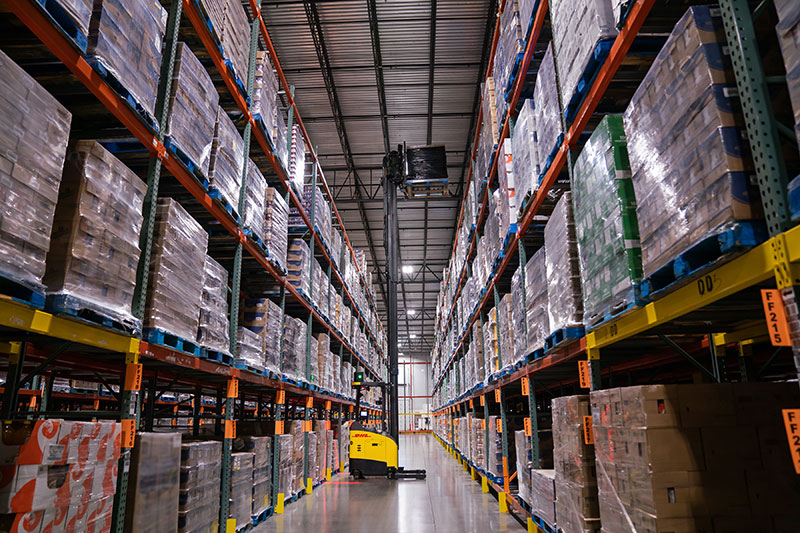Digitalization takes many forms across the supply chain, from the software systems that improve efficiency and sustainability in complex transportation networks to the mobile robots that dramatically increase the productivity of picking operations across the DHL Supply Chain network.
One of the latest frontiers for digitalization in the warehouse has been pallet handling. Some automated pallet handling solutions are in use today, but they generally don’t deliver the flexibility today’s warehouses require. Automated Guide Vehicles (AGVs), for example, can be valuable in performing repetitive tasks where pallets are moved from one location to another across a fixed path, but cannot address the need to automate high-value tasks or easily adapt to process or order profile changes.
Pallet storage and retrieval systems are another option, but they are limited in their flexibility due to their fixed infrastructure. They are also often not feasible for established warehouses because of the disruption required to deploy them. Few warehouses can afford to shut down a significant portion of their storage capacity for a year or more while a pallet shuttle is being installed.
Unconventional Thinking
The solution lies in automating the very system used in virtually every warehouse that is handling pallets today – the forklift. Forklifts are inherently flexible due to their mobility and can be deployed without any changes to existing warehouse systems.
The key question is whether the new generation of autonomous forklifts can handle the complex and dynamic warehouse tasks that will enable them to serve as more than glorified AGVs. To find out, we went against conventional thinking that suggests autonomous vehicles should be implemented on simpler tasks so that warehouse operators can get comfortable with the technology and the first deployment has a high likelihood of success. Instead, we decided to deploy autonomous forklifts on the most difficult and high-value process in the pallet warehouse: high-reach, double deep, pallet putaway and picking.
Putting Autonomous Forklifts to the Test
We embarked on this first deployment because our organization has identified indoor robotic transport as one of the major opportunities for automation across our network in which forklifts travel more than 25 million miles per year. Making those processes more automated is particularly critical today, considering the current labor environment. The shortage of skilled drivers can not only limit network growth but also ultimately reduce service levels if the situation becomes too severe. Even when drivers are available, the ramp-up time required for recruiting and training can limit supply chain agility and growth.
Through our technology selection process at DHL Supply Chain, which integrates industrial engineering, operations and IT specialists, we identified the best solution for the complex use case. Although this was the first installation of autonomous forklifts, we have confidence in our ability to vet new technology and our processes for introducing technology into the supply chain.
One of the keys to our ability to successfully introduce new technology is that we don’t attempt to replace a manual process with automation – which typically leads to unexpected complications and can crater a first deployment. Rather, at DHL Supply Chain, we design a new process around the automation.
The new process involved introducing a new workflow of products in the warehouse, and it was important to integrate this automation process within our existing Warehouse Management System (WMS). Automating picking and putaway using autonomous forklifts also created opportunities for some of the forklift operators to focus on more strategic, value-added tasks.
The dual-mode capability of the trucks proved valuable during the transition phase in this part of the warehouse. Placing pallets on the top rows of a double deep rack is a challenging task for even the most experienced warehouse operators, resulting in some out-of-skew exceptions that could not be picked in autonomous mode. As inventory rotates and more pallets are put away by the autonomous forklifts, the number of exceptions naturally decreases, and the trucks will operate in autonomous mode continually.
Building on Success
Based on the success of this first deployment at DHL Supply Chain, we are excited about the role this technology will play in the future of warehousing. We will be scaling the use of autonomous forklifts throughout our network, as applicable.
The productivity of the autonomous forklifts has exceeded expectations and the speed of the vehicles is particularly strong when performing tasks at the top rows of the rack where human operators are the least visually accurate. The productivity of the trucks is also enhanced by their ability to work continuously over multiple shifts without breaks, except for battery charging. Finally, autonomous forklifts have allowed us to re-assign operators to other areas of the warehouse, alleviating the constant pressure on recruiting and improving our ability to grow with our customers.
To learn more about how DHL Supply Chain is harnessing the power of digitalization to create the warehouse of the future, visit http://app.supplychain.dhl.com/e/er?s=1897772577&lid=9907.
SC
MR


Latest Supply Chain News
- 6 Questions With … Sandeep Bhide
- MIT CTL offering humanitarian logistics course
- Bridging the ESG gap in supply chain management: From ambition to action
- Few executives believe their supply chains can respond quickly to disruptions
- Technology’s role in mending supply chain fragility after recent disruptions
- More News
Latest Podcast

 Explore
Explore
Software & Technology News
- Technology’s role in mending supply chain fragility after recent disruptions
- Tech investments bring revenue increases, survey finds
- Survey reveals strategies for addressing supply chain, logistics labor shortages
- AI, virtual reality is bringing experiential learning into the modern age
- Humanoid robots’ place in an intralogistics smart robot strategy
- Tips for CIOs to overcome technology talent acquisition troubles
- More Software & Technology
Latest Software & Technology Resources

Subscribe

Supply Chain Management Review delivers the best industry content.

Editors’ Picks





